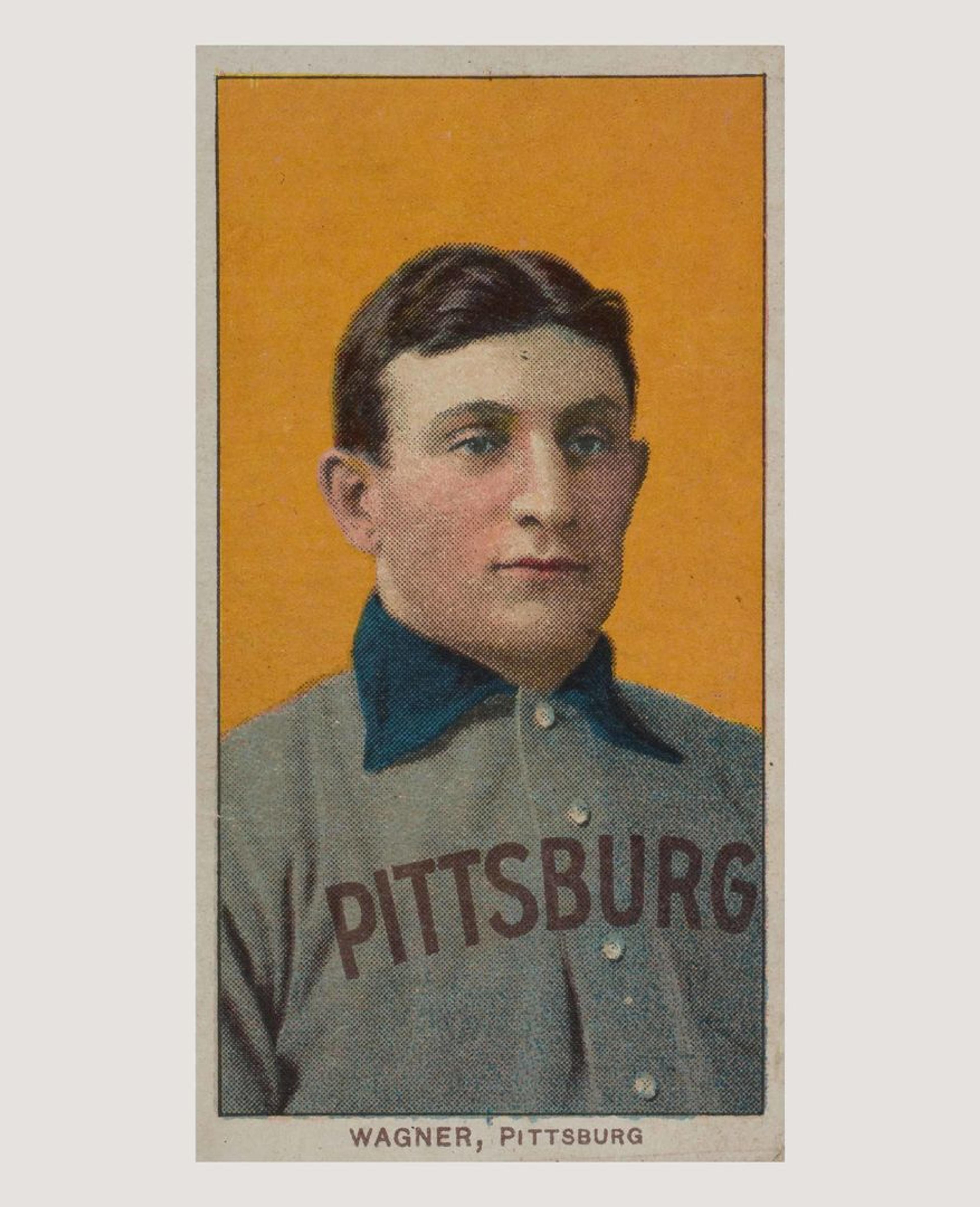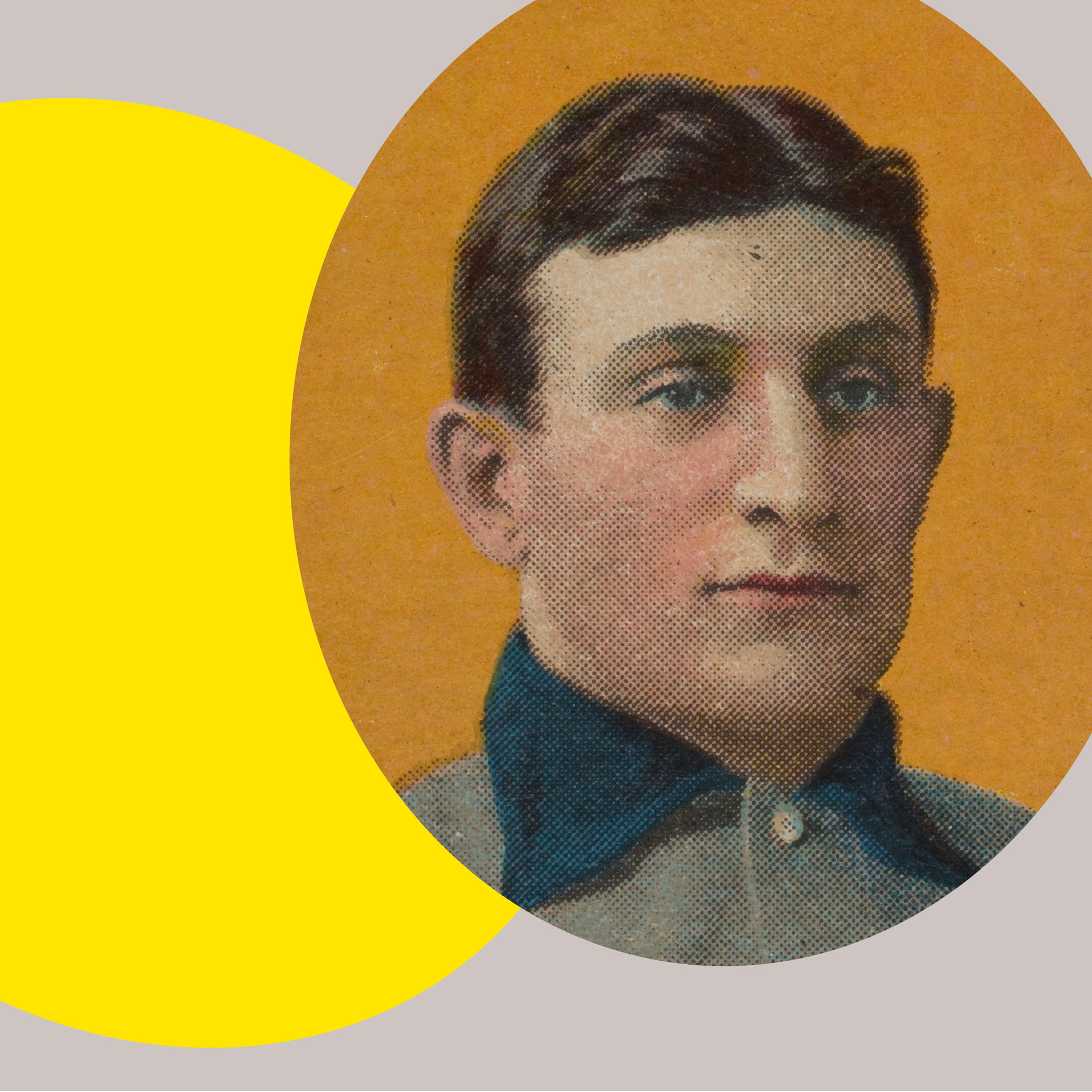Met curator Allison Rudnick and journalist Dave Jamieson discuss the Honus Wagner baseball card (1909–11).
Tracing Economics through Ephemera
Honus Wagner Baseball Card
Listen to the conversation, learn more about the artwork, and read the transcript below.

Issued by American Tobacco Company (American, active 1890–1994). Honus Wagner, Pittsburgh, National League, from the White Border series (T206) for the American Tobacco Company, 1909–11. Commercial lithograph, 2 5/8 x 1 1/2 in. (6.7 x 3.7 cm). The Metropolitan Museum of Art, New York, The Jefferson R. Burdick Collection, Gift of Jefferson R. Burdick (63.350.246.206.378)
The Met’s baseball card collection, which includes more than 30,000 cards, constitutes the largest public collection of its type outside of the Baseball Hall of Fame in Cooperstown, New York. The Honus Wagner is the rarest card in the vast collection, due to its limited print run. It was issued by the American Tobacco Company to promote cigarettes and loose tobacco. The Wagner card, as well as the larger collection to which it belongs, is an integral part of the Museum’s holdings of ephemera and presents a history of America’s favorite pastime as well as popular printmaking in the United States.
Transcript
ALLISON RUDNICK: I am Allison Rudnick, associate curator in the Department of Drawings and Prints at The Metropolitan Museum of Art.
DAVE JAMIESON: I’m Dave Jamieson, I’m a journalist and I wrote a book called Mint Condition: How Baseball Cards Became an American Obsession.
—
JAMIESON: So this card is the T206 Honus Wagner made by the American Tobacco Company in 1909. There’s believed to be probably somewhere between fifty and a hundred still in existence. It’s really considered the holy grail of baseball-card collecting, and there’s a lot of mystery around why it is so rare.
RUDNICK: Something that strikes me is that I would say Honus Wagner is not a household name, he’s best known because of this card.
Dave, do you want to just give some background on Honus Wagner as a person and who he was?
JAMIESON: Sure. You know, Honus Wagner is one of the best baseball players of his era. He was a shortstop for the Pittsburgh Pirates and really one of the best shortstops to ever play the game. He had more than three thousand hits, which was a record at the time. He helped lead Pittsburgh to a World Series win in 1909.
So I think a lot of people see him in the news to this day because of his baseball card and it selling for insane amounts of money, but he was, you know, really one of the best to play the game.
RUDNICK: The T206, which is the set that the Honus Wagner card was issued in, stands for twentieth-century tobacco, and 206 indicates that this was the 206th set.
The Honus Wagner card is a pretty simple player portrait against this yellow monochrome background. It is, of course, based on a photograph of Honus Wagner.
The card is, as you say, extremely valuable, and that’s because the card is so rare. I thought it would be useful for us to talk about why there are so few Honus Wagner cards out there in the world and why, of course, this card has fetched millions of dollars at auction in the last several years.
JAMIESON: So this card only underwent a limited print run. There’s a couple different theories on that. What we do know is that Wagner objected to his likeness being used in this set, and that that is probably why the run was cut short. We don’t exactly know why.
One leading theory, and this is one that has been promoted by Wagner’s descendants, is that he didn’t like the idea of his image being used to promote tobacco. That would make him, you know, a visionary of a kind to object to that and not wanting children tying his likeness to tobacco.
Another possibility is that he felt like he deserved some money for his image being used. And, you know, I think that would make him a visionary of another sort. And I say that because this was in an era when athletes didn’t really capitalize on their publicity value. They basically weren’t given anything, or only something small, for their pictures being used on cards.
So the truth is we don’t know definitively why he objected, but we do know that that's why this card is so rare.
RUDNICK: I think that both of those legends that have been perpetuated actually tell us a lot about the history of baseball-card collecting, both before the Honus Wagner card was issued and after. So much of its history is about commerce, industry, profit, consumerism, these features of capitalism.
JAMIESON: Yeah, the founding of baseball cards was really about the promotion of tobacco, probably expressly promoting tobacco to children. When they were created in the 1880s, they were a marketing vehicle, and this was the beginning of a long and strange history where baseball cards are tied to certain products that they’re marketing. But in reality, this became eventually about the baseball cards themselves.
Around the 1960s and ’70s, hardcore collectors really started traveling the country and trying to find rare gems like the Wagner card. In the 1980s, we see this baseball card craze really explode. And, you know, I came of age in that time, and we spent unknown hours just trading cards and trying to assemble our sets, but also, at that point, very much aware of these cards as something that could be valuable. There were price guides that were out in the 1980s that were basically like stock tickers, and we could see, you know, if our trade from last month turned out to be a wise one.
So, you know, the Wagner card sort of epitomizes the evolution of baseball cards from this piece of ephemera, something that was, you know, meant to be collected but not necessarily hung onto forever, into basically a really valuable commodity.
In 1960, I think it was valued at around $50 maybe, which would have been a huge sum then. But, of course, a T206 Honus Wagner recently sold for more than $6 million at auction—that's the highest amount any baseball card has ever gone for. And there are different versions of the Wagner out there, maybe another one will turn up and go for even more than that.
RUDNICK: So much of the history of baseball cards is enmeshed with the market, but these baseball cards also present to us a history of commercial printing techniques. They give contemporary audiences a sense of people’s values too. For centuries knowledge was spread through the printed image. That’s how people were educated, consumed the news, learned about current events, all sorts of things.
Baseball cards kind of fall into this category of a printed image that allowed, for decades, collectors and those who bought the gum packs and bought the cigarette packs to, kind of, behold an image of their favorite baseball player.
JAMIESON: This was an important way that people experienced the game, too. It was not like today where you could, you know, go online and pull up the highlights. So I think these cards being housed in The Met is a certain affirmation of these cards’ cultural value and the importance they had to the people who were collecting them at the time.
###
